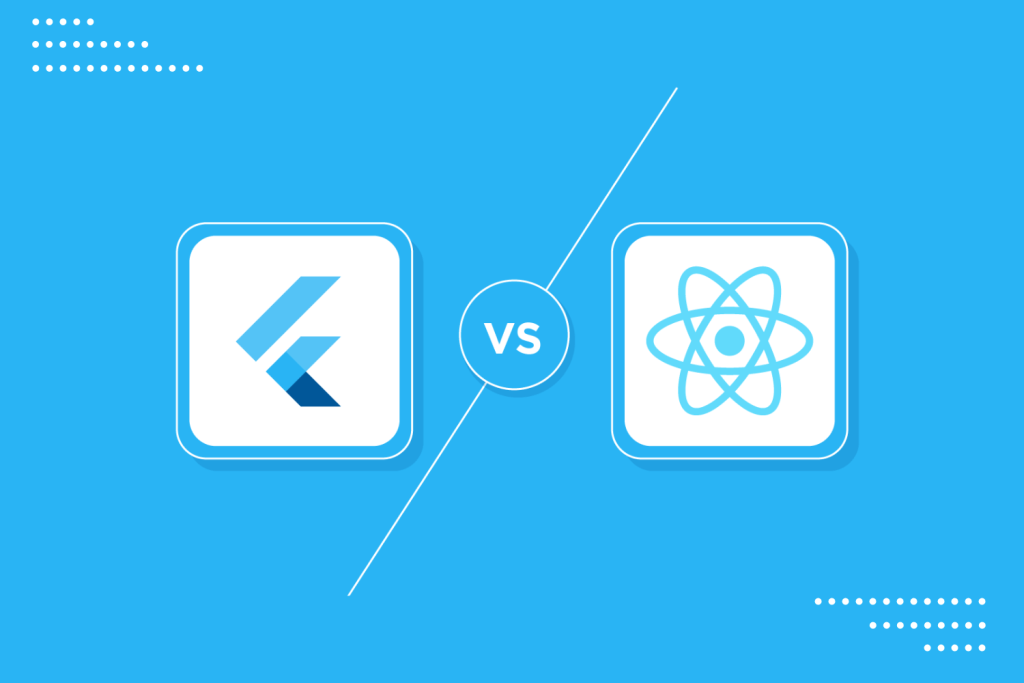Flutter vs React, In the world of cross-platform mobile app development, two frameworks have emerged as leaders: Flutter and React Native. Both offer unique advantages and have their own set of challenges.
In this blog, we will discuss these two popular frameworks and help you decide which one to choose in 2025.
Flutter
Flutter, an open-source UI software development kit created by Google, has significantly impacted the mobile app development sector since its inception in 2017. As we approach 2025, Flutter continues to evolve, offering a speedy development process, high performance, and expressive UI. This blog post will explore the current trends in Flutter app development and the future of Flutter in the increasingly competitive app development market.
Why Choose Flutter?
Flutter is leading the mobile development space, and this isn’t by chance as we approach 2025. Several factors, including improved performance, a growing community, and the possibility of shorter development times, have contributed to its increasing prominence.
Cross-Platform Capabilities
In 2025, Flutter will still be a severe competitor to app development because of its cross-platform capabilities. Its open-source nature, which Google supports, increases its popularity, and its growth onto desktop and online platforms widens its appeal even further.
Good Performance
Flutter provides a set of widgets, animations, and tools that make app development easier and more enjoyable. It offers good performance, a vibrant community, and a wealth of UI/UX design possibilities.
Key Features of Flutter
- Cross-Platform Capability: Flutter allows you to build apps for mobile, web, and desktop from a single codebase.
- Instant Code Updates: Changes in the code are reflected in real-time.
- Extensive Widget Library: Flutter provides a rich set of widgets for creating complex custom interfaces.
- Native-Like Performance: Flutter apps run in a smooth and fast manner, similar to native apps.
- Open-Source Framework: Flutter is open-source, which means it’s free to use and has a large community of contributors.
Pros of Flutter
- Hot Reload: This feature allows developers to experiment, build UIs, add features, and fix bugs faster.
- Expressive and Flexible UI: With Flutter, it’s easy to customize the existing widgets or create your own.
- Native Performance: Flutter includes all the critical platform differences such as scrolling, navigation, icons, and fonts to provide full native performance on iOS and Android.
Cons of Flutter
- Limited Libraries: Flutter is still growing and does not have support for all the libraries you may need.
- Large File Sizes: Applications built with Flutter tend to be larger than native ones.
React Native
React Native, a JavaScript framework for writing real, natively rendering mobile applications for iOS and Android, has been a game-changer in the mobile app development industry since its inception by Facebook. As we approach 2025, React Native continues to evolve, offering a speedy development process, high performance, and expressive UI. This blog post will explore the current trends in React Native app development and the future of React Native in the increasingly competitive app development market.
Also read | Top 10 Cybersecurity trends to expect in 2025
Why Choose React Native?
React Native is leading the mobile development space, and this isn’t by chance as we approach 2024. Several factors, including improved performance, a growing community, and the possibility of shorter development times, have contributed to its increasing prominence.
Cross-Platform Capabilities
In 2025, React Native will continue to thrive as the preferred framework for cross-platform app development. Its ability to create high-quality, single-code-based applications will streamline the development process for businesses seeking a global market presence.
Good Performance
React Native provides a set of components, animations, and tools that make app development easier and more enjoyable. It offers good performance, a vibrant community, and a wealth of UI/UX design possibilities.
Key Features of React Native
- Cross-Platform Capability: React Native allows you to build apps for iOS and Android from a single codebase.
- Component Reusability: Components can be reused, which can save development time.
- Native-Level Performance: React Native apps run smoothly and quickly, similar to native apps.
- Vibrant Community: React Native has a large and active community of developers.
- Effortless Code Iteration: Changes in the code are reflected in real-time.
- Adaptability: React Native is highly adaptable and customizable.
Pros of React Native
- Community Driven: React Native is backed by a strong community that keeps the framework up-to-date and helps in solving issues.
- Code Reusability & Cost Saving: With React Native, you can use the same code for deployment on both iOS and Android platforms.
- Live and Hot Reloading: This is a great feature that drastically cuts down the waiting time for changes to take effect.
Cons of React Native
- Performance: React Native is slower compared to Flutter and native app development.
- Complex UI: It’s harder to create complex animations and transitions with React Native.
Flutter vs React Native: The Showdown
| Criteria | Flutter | React Native |
|---|---|---|
| Language | Dart | JavaScript |
| Performance | High | Moderate |
| Community Support | Growing | Large |
| UI Experience | Excellent | Good |
| Learning Curve | Moderate | Easy |
Flutter vs React, The choice between Flutter and React Native would depend on your specific needs and resources. If you have a team proficient in JavaScript, React Native could be the better choice. On the other hand, if you’re aiming for superior performance and a beautiful UI, Flutter would be the way to go.

